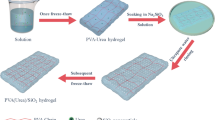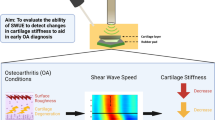Abstract
The extracellular matrix of articular cartilage modulates the mechanical signals sensed by the chondrocytes. In the present study, a finite element model (FEM) of the chondrocyte and its microenvironment was reconstructed using the information from fourier transform infrared imaging spectroscopy. This environment consisted of pericellular, territorial (mainly proteoglycans), and inter-territorial (mainly collagen) matrices. The chondrocyte, pericellular, and territorial matrix were assumedto be mechanically isotropic and poroelastic, whereas the inter-territorial matrix, due to its high collagen content, was assumed to be transversely isotropic and poroelastic. Under instantaneous strain-controlled compression, the FEM indicated that the fluid pressure within the chondrocyte increased nonlinearly as a function of the in-plane Young’s modulus of the collagen network. Under instantaneous force-controlled compression, the chondrocyte experienced the highest fluid pressure when the in-plane Young’s modulus of the collagen network was ~4 MPa. Based on the present results, the mechanical characteristics of the collagen network of articular cartilage can modify fluid flow and stresses in chondrocytes. Therefore, the integrity of the collagen network may be an important determinant in cell stimulation and in the control of the matrix maintenance.
Similar content being viewed by others
References
Akizuki S, Mow VC, Muller F, Pita JC, Howell DS, Manicourt DH (1986) Tensile properties of human knee joint cartilage: I. Influence of ionic conditions, weight bearing, and fibrillation on the tensile modulus. J Orthop Res 4:379–392
Alexopoulos LG, Haider MA, Vail TP, Guilak F (2003) Alterations in the mechanical properties of the human chondrocyte pericellular matrix with osteoarthritis. J Biomech Eng 125:323–333
Alexopoulos LG, Williams GM, Upton ML, Setton LA, Guilak F (2005) Osteoarthritic changes in the biphasic mechanical properties of the chondrocyte pericellular matrix in articular cartilage. J Biomech 38:509–517
Arokoski JP, Hyttinen MM, Lapveteläinen T, Takacs P, Kosztaczky B, Modis L, Kovanen V, Helminen H (1996) Decreased birefringence of the superficial zone collagen network in the canine knee (stifle) articular cartilage after long distance running training, detected by quantitative polarised light microscopy. Ann Rheum Dis 55:253–264
Buschmann MD, Kim YJ, Wong M, Frank E, Hunziker EB, Grodzinsky AJ (1999) Stimulation of aggrecan synthesis in cartilage explants by cyclic loading is localized to regions of high interstitial fluid flow. Arch Biochem Biophys 366:1–7
Camacho NP, West P, Torzilli PA, Mendelsohn R (2001) FTIR microscopic imaging of collagen and proteoglycan in bovine cartilage. Biopolymers 62:1–8
Charlebois M, McKee MD, Buschmann MD (2004) Nonlinear tensile properties of bovine articular cartilage and their variation with age and depth. J Biomech Eng 126:129–137
Chen CT, Bhargava M, Lin PM, Torzilli PA (2003) Time, stress, and location dependent chondrocyte death and collagen damage in cyclically loaded articular cartilage. J Orthop Res 21:888–898
Clark AL, Barclay LD, Matyas JR, Herzog W (2003) In situ chondrocyte deformation with physiological compression of the feline patellofemoral joint. J Biomech 36:553–568
Cohen B, Lai WM, Mow VC (1998) A transversely isotropic biphasic model for unconfined compression of growth plate and chondroepiphysis. J Biomech Eng 120:491–496
Eggli PS, Hunziker EB, Schenk RK (1988) Quantitation of structural features characterizing weight- and less- weight-bearing regions in articular cartilage: a stereological analysis of medial femoral condyles in young adult rabbits. Anat Rec 222:217–227
Elliott DM, Narmoneva DA, Setton LA (2002) Direct measurement of the Poisson’s ratio of human patella cartilage in tension. J Biomech Eng 124:223–228
Freeman PM, Natarajan RN, Kimura JH, Andriacchi TP (1994) Chondrocyte cells respond mechanically to compressive loads. J Orthop Res 12:311–320
Guilak F (1995) Compression-induced changes in the shape and volume of the chondrocyte nucleus. J Biomech 28:1529–1541
Guilak F (2000) The deformation behavior and viscoelastic properties of chondrocytes in articular cartilage. Biorheology 37:27–44
Guilak F, Mow VC (2000) The mechanical environment of the chondrocyte: a biphasic finite element model of cell-matrix interactions in articular cartilage. J Biomech 33:1663–1673
Guilak F, Meyer BC, Ratcliffe A, Mow VC (1994) The effects of matrix compression on proteoglycan metabolism in articular cartilage explants. Osteoarthritis Cartilage 2:91–101
Guilak F, Sah RL, Setton LA (1997) Physical regulation of cartilage metabolism. In: Mow VC, Hayes WC (eds) Basic orthopaedic biomechanics. Lippincott-Raven, Philadelphia, pp. 179–207
Guilak F, Jones WR, Ting-Beall HP, Lee GM (1999) The deformation behavior and mechanical properties of chondrocytes in articular cartilage. Osteoarthritis Cartilage 7:59–70
Hing WA, Sherwin AF, Poole CA (2002) The influence of the pericellular microenvironment on the chondrocyte response to osmotic challenge. Osteoarthritis Cartilage 10:297–307
Huyghe JM, Janssen JD (1997) Quadriphasic mechanics of swelling incompressible porous media. Int J Engng Sci 35:793–802
Jones WR, Ting-Beall HP, Lee GM, Kelley SS, Hochmuth RM, Guilak F (1999) Alterations in the Young’s modulus and volumetric properties of chondrocytes isolated from normal and osteoarthritic human cartilage. J Biomech 32:119–127
Julkunen PK, Kiviranta P, Lindgren R, Wilson W, Jurvelin JS, Korhonen RK (2005) Estimation of mechanical characteristics of articular cartilage from quantitative microcopic images. Trans Orthop Res Soc 30:348
Kempson GE (1991) Age-related changes in the tensile properties of human articular cartilage: a comparative study between the femoral head of the hip joint and the talus of the ankle joint. Biochim Biophys Acta 1075:223–230
Kim YJ, Bonassar LJ, Grodzinsky AJ (1995) The role of cartilage streaming potential, fluid flow and pressure in the stimulation of chondrocyte biosynthesis during dynamic compression. J Biomech 28:1055–1066
Király K, Lapveteläinen T, Arokoski J, Törrönen K, Modis L, Kiviranta I, Helminen HJ (1996) Application of selected cationic dyes for the semiquantitative estimation of glycosaminoglycans in histological sections of articular cartilage by microspectrophotometry. Histochem J 28:577–590
Koay EJ, Shieh AC, Athanasiou KA (2003) Creep indentation of single cells. J Biomech Eng 125:334–341
Korhonen RK, Laasanen MS, Toyras J, Lappalainen R, Helminen HJ, Jurvelin JS (2003a) Fibril reinforced poroelastic model predicts specifically mechanical behavior of normal, proteoglycan depleted and collagen degraded articular cartilage. J Biomech 36:1373–1379
Korhonen RK, Saarakkala S, Töyräs J, Laasanen MS, Kiviranta L, Jurvelin JS (2003b) Experimental and numerical validation for the novel configuration of an arthroscopic indentation instrument. Phys Med Biol 48:1565–1576
Lane Smith R, Trindade MC, Ikenoue T, Mohtai M, Das P, Carter DR, Goodman SB, Schurman DJ (2000) Effects of shear stress on articular chondrocyte metabolism. Biorheology 37:95–107
Leipzig ND, Athanasiou KA (2005) Unconfined creep compression of chondrocytes. J Biomech 38:77–85
Li LP, Soulhat J, Buschmann MD, Shirazi-Adl A (1999) Nonlinear analysis of cartilage in unconfined ramp compression using a fibril reinforced poroelastic model. Clin Biomech 14:673–682
Likhitpanichkul M, Guo XE, Lai WM, Mow VC (2004) Tension-compression nonlinearity influences the mechano-electrochemical environment of chondrocytes in cartilage under unconfined compression. Trans Orthop Res Soc 29:525
Mow VC, Kuei SC, Lai WM, Armstrong CG (1980) Biphasic creep and stress relaxation of articular cartilage in compression: theory and experiments. J Biomech Eng 102:73–84
Potter K, Kidder LH, Levin IW, Lewis EN, Spencer RG (2001) Imaging of collagen and proteoglycan in cartilage sections using Fourier transform infrared spectral imaging. Arthritis rheum 44:846–855
Quinn TM, Allen RG, Schalet BJ, Perumbuli P, Hunziker EB (2001) Matrix and cell injury due to sub-impact loading of adult bovine articular cartilage explants: effects of strain rate and peak stress. J Orthop Res 19:242–249
Rieppo J, Hyttinen MM, Jurvelin JS, Helminen HJ (2004) Reference sample method reduces the error caused by variable cryosection thickness in Fourier transform infrared imaging. Appl Spectrosc 58:137–140
Rieppo J, Ruotsalainen H, Töyräs J, Kurkijärvi J, Kiviranta I, Hyttinen MM, Jurvelin JS, Helminen HJ (2005) FTIR imaging of the composition of territorial and interterritorial matrix of human articular cartilage. Trans Orthop Res Soc 30:1500
Sah RL, Yang AS, Chen AC, Hant JJ, Halili RB, Yoshioka M, Amiel D, Coutts RD (1997) Physical properties of rabbit articular cartilage after transection of the anterior cruciate ligament. J Orthop Res 15:197–203
Setton LA, Mow VC, Muller FJ, Pita JC, Howell DS (1994) Mechanical properties of canine articular cartilage are significantly altered following transection of the anterior cruciate ligament. J Orthop Res 12:451–463
Shin D, Athanasiou K (1999) Cytoindentation for obtaining cell biomechanical properties. J Orthop Res 17:880–890
Soltz MA, Ateshian GA (2000) A conewise linear elasticity mixture model for the analysis of tension- compression nonlinearity in articular cartilage. J Biomech Eng 122:576–586
Soulhat J, Buschmann MD, Shirazi-Adl A (1999) A fibril-network-reinforced biphasic model of cartilage in unconfined compression. J Biomech Eng 121:340–347
Stockwell RA (1987) Structure and function of the chondrocyte under mechanical stress. In: Helminen HJ, Kiviranta I, Tammi M (eds) Joint loading: biology and health of articular structures. Wright and Sons, Bristol, pp. 126–148
Trickey WR, Lee GM, Guilak F (2000) Viscoelastic properties of chondrocytes from normal and osteoarthritic human cartilage. J Orthop Res 18:891–898
Trickey WR, Vail TP, Guilak F (2004) The role of the cytoskeleton in the viscoelastic properties of human articular chondrocytes. J Orthop Res 22:131–139
Williamson AK, Chen AC, Masuda K, Thonar EJ, Sah RL (2003) Tensile mechanical properties of bovine articular cartilage: variations with growth and relationships to collagen network components. J Orthop Res 21:872–880
Wilson W, van Donkelaar CC, van Rietbergen B, Ito K, Huiskes R (2004) Stresses in the local collagen network of articular cartilage: a poroviscoelastic fibril-reinforced finite element study. J Biomech 37:357–366
Wu JZ, Herzog W (2002) Elastic anisotropy of articular cartilage is associated with the microstructures of collagen fibers and chondrocytes. J Biomech 35:931–942
Wu JZ, Herzog W, Epstein M (1999) Modelling of location- and time-dependent deformation of chondrocytes during cartilage loading. J Biomech 32:563–572
Author information
Authors and Affiliations
Corresponding author
Rights and permissions
About this article
Cite this article
Korhonen, R.K., Julkunen, P., Rieppo, J. et al. Collagen Network of Articular Cartilage Modulates Fluid Flow and Mechanical Stresses in Chondrocyte. Biomech Model Mechanobiol 5, 150–159 (2006). https://doi.org/10.1007/s10237-006-0021-6
Received:
Accepted:
Published:
Issue Date:
DOI: https://doi.org/10.1007/s10237-006-0021-6




